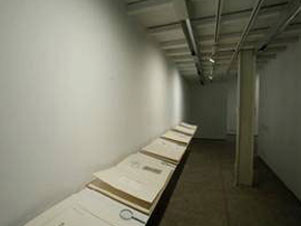Sunanda K Sanyal
(Catalog Essay, 2012)
Subhadarshini Singh’s art is deeply involved with the subject of medicine, both modern and ancient, Indian and Western. A legacy of her experience as a medical journalist, it is unambiguously central to her creative enterprise. What interests me, however, is not so much the subject itself, nor the artist’s strong passion for it, but the larger question –an obvious one to me– raised by the impressive volume of her production of the last few years: what does such undying focus on a specific subject mean in the discourse of contemporary art? And against her so-called self-taught background in art, this question appears all the more crucial.
Let me clarify at the outset that how the artist herself responds to this question is not my primary clue in this critique. Discussion of art with exclusive attention to the artist’s intentions was the practice of a bygone era, when meaning of images was believed to be the sole prerogative of the artist. The critical discourse of the last few decades has decisively eradicated the notion that art carries some essential “Truth”. Interpretation is now seen as an open-ended, ongoing dialog offered by the informed viewer/reader/critic, where disparity of opinions leads to further investigation, leaving something for posterity to explore. So my reading of Singh’s work may differ significantly from her own, or that of some other critic; and this, in my mind, is perfectly alright.
Singh’s pictures are figurative and, frequently, decorative. Introduced by explicit titles, they are colorful narrative images on numerous aspects of the history of medicine. The individual themes ably demonstrate her extensive knowledge of the area, particularly her insight into some of its quirky sides (more about this later). The subject of medicine, illness and doctors would very likely prompt some critics to apply Michel Foucault’s theory, found primarily in his celebrated book “Birth of the Clinic”, to engage with Singh’s art. They would probably be anxious to see complex discourses of power and gaze, and objectification of the body at work in the images. But if we, for a moment, can avoid being trapped by the superficial dazzle of such hasty application of half-digested postmodern theories, perhaps we can see that Singh’s work doesn’t even lend itself well to a Foucauldian analysis. Rather, I believe an exploration of the narrative element, coupled with a critical look at her idiosyncratic use of disparate pictorial conventions can offer a far more meaningful understanding of her creative output.
A significant portion of modernist art in the West –chiefly the abstractions (from Kandinsky to the American Abstract Expressionists) as well as some figurations (Matisse, for instance)– had a disdain for narrative. Particularly toward the middle of the last century, the narrative potential of a picture, along with figuration, was forcefully discarded, and a picture was meant to underscore the subjectivity of the artist; it became an index to what was believed to be the artist’s unmediated exploration of life. This existential shift happened partly due to the monumental destruction of Word War II, which caused a loss of faith for many artists in the potential of the human image to represent any noble ideas; and partly due to the culture clash of the Cold War, which compelled –primarily the American avant-garde– to sharply distinguish between modernism and the social realism practiced under the communist regimes. But then again, this was an occidental discourse. In countries freed from colonial rule in mid-century, the self-referential rhetoric of modernism had little significance. The circumstances in India, for example, made figuration crucial to the generation of F.N. Souza and M.F. Husain; figurative narratives about the trials and tribulations of a young nation had an unequivocal priority over the primacy of the artist as the central subject, which is why there has never been a notable legacy of abstraction in modern Indian art. Alternatively, Indian modernism drew from the Symbolists, the Cubists, the German Expressionists, the Surrealists, and later, from such postwar artists as Henry Moore and Francis Bacon.
Beginning in the 1970s, the anti-narrative modernism in Europe and America was challenged by the kind of art loosely branded postmodernist, much of which revived figurative narrative with the same vigor with which it had been rejected. This trend, however, did not enter the Indian art scene noticeably until the 1990s. With regard to narrative, then, one of the tricky tasks of contemporary Indian figurative artists –and I would include Singh among them—has been to define their individual positions in the complex gray zone around the two kinds of narrative strands of modern art. The modernist one, despite its occasional playfulness, is a serious, earnest enterprise, engaged in dialogs with society, the artist’s self, and with the complexities of an aesthetic paradigm—an art with a mission, so to speak. Much of the postmodernist narrative, on the other hand, is willfully open-ended, ironic and self-reflexive, often deconstructing its own ontology through a process of becoming. It frequently transgresses the barrier between high culture and kitsch and appropriates from disparate sources to expose power relations in society, yet rarely makes any commitment to a specific ideology or political agenda.
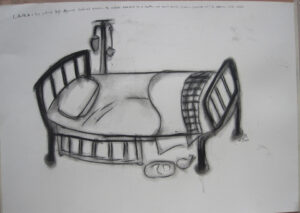
L.A.M.A. (left against medical advice)
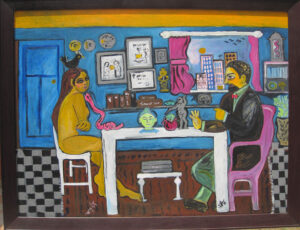
100 Years of Humiliation at Psychoanalysis
Most of Singh’s titles are provocative. Some of the unusual phrasings (Left Against Medical Advice, 100 Years of Humiliation at Psychoanalysis) appear humorous, even tongue-in-cheek, which is quite contrary to modernist conventions. Even the brief ones with symbolic overtones, such as Comfort, tempt us to locate a strong irony in the imagery of a hot-water bag labeled “Coronation”, with quasi-poetic texts scribbled around it. Indeed, compared with the exhibits of the 2011 show “Medical Dreamtime”, more of the current images seem to demonstrate this tendency. And yet, when we find the metaphor of laying oneself bare in front of the shrink turn into literal nakedness; when an unclothed woman, with a singing bird atop her head and a snake climbing her breasts, sits across the table from a psychiatrist uncannily resembling Sigmund Freud, it becomes apparent that a dark humor, perhaps a sarcasm, rather than a deliberate irony, is responsible for the quirkiness of the image. Locked between the checkered patterns of the floor and set against a blue wall with books and trophies associated with healing, the woman looks visibly passive vis-à-vis the active doctor. Everything in the room, from the window exposing a sprawling cityscape to the small nude statue and the head of Buddha on the table, seems to be mocking her predicament. It is “humiliation” indeed. Or, when a quick perusal of the texts in Comfort informs us of the sad yearnings of a patient, the seemingly ironic image turns out to be a testimony to a palpable anxiety about suffering, which betrays the artist’s earnestness about the subject.
To examine Singh’s work exclusively through the postmodernist lens, therefore, is to miss the point. Hers is not a self-consciously postmodernist enterprise; the self-reflexive, deconstructionist strategies of postmodernist art are conspicuously missing from her pictures. Despite their humor, they basically tell stories with dead seriousness, betraying a deep reverence for the wonders of healing. Furthermore, while compassion for human suffering is evident in such pictures as Born Defective, Left Against…., and Comfort, humanity in Singh’s work is stereotyped at the expense of a more critical approach to the social role of medicine. Perhaps Singh’s own class origin can explain why the power and class dynamics, which so brutally inform the discourse of maladies and medicine in a country like India, is so glaringly absent in her imagery. There is no question, then, that Singh’s playfulness, even her sarcasm, actually underscores a deeply romantic modernist vision of medicine as well as art. The question is, in light of this understanding, how do we treat Singh’s own claim that she is an “outsider” artist?

Comfort

Born Defective
The category of “outsider” art is fundamentally problematic. An “outside” invariably presupposes an opposing “inside”; and scholarship has demonstrated beyond question that far from being natural spaces, both of them are constructs of the discourse of modern art. The French avant-garde that challenged the official bourgeois taste in the nineteenth century knew well that despite its revolutionary edge, it belonged to the same capitalist culture as the art academies which catered to that taste. Therefore, in order to find an escape from that “inside”, they merely invented an “outside” (or, more precisely, several “outsides”). This view acquired the name “Primitivism”, which has an immensely complex history, with multiple ramifications. Initially, the Primitives whom the post-Impressionists revered were pre-Renaissance European artists, whose art, they believed, was unencumbered by the mandates of the Italian Renaissance, such as mathematical perspective and chiaroscuro. For the rising modernists, such images evinced a simpler, more elemental visual language that was compatible with their own creative goals. In short, it was a fascination for an otherness in combating what they considered a decadent industrial culture. This urge to be inspired by the exotic also led to the “discovery” of idyllic spaces in contemporary French society, an outcome of which was the artists’ colony in the village of Pont-Aven in Brittany, northern France, where Paul Gauguin lived for a while. Then, around the turn of the century, the Primitivist curiosity opened the doors to distant, exotic cultures of Africa, the South Pacific and other regions, resulting in the groundbreaking innovations of the Cubists, the Fauves, the German Expressionists, and the Surrealists. What is relevant here for our purposes is the curiosity about yet another kind of artists within contemporary European societies, who represented another “outside” of this sort. They were called “naïve”, “visionary”, and “urban folk” (a prime example in the nineteenth century was the French artist Henri Rousseau), until the critic Roger Cardinal branded them with the title “outsider” as late as 1972. The term acquired a maverick status in the discourse of modern art.
The “inside/outside” dichotomy, then, is an art-historical invention pure and simple. And from that perspective, any attempt to assign Singh a specific position with regard to “outsider” artists is bound to be futile, since that would imply, quite erroneously, that there is, in fact, a stable existence of these two spaces. I shall, instead, devote the remainder of this essay to exposing the fundamentally unstable nature of this historical binary by further dissecting its essentialized character in order to prevent any pigeon-holing of Singh’s work.
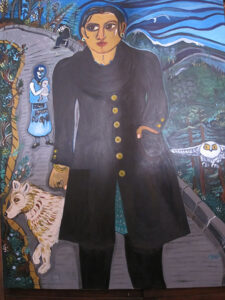
Anxiety
One of the ways “outsider” art has been distinguished from canonical art is by arguing the difference in its pictorial construction—everything from formal and iconographical choices to use of tools and materials, not to mention its vision of content. And since institutional training initially served as a foil in such evaluations, lack of training primary qualified an artist for inclusion in this category. In the nineteenth century, when academic training was unavoidable for an artist’s career, and when the art academies had strict mandates for methods of instruction and aesthetic priorities, the difference between a schooled and an unschooled artist was glaring indeed; Henri Rousseau’s pictorial logic was incomprehensibly alien to any academic artist in that era. The twentieth century, however, gradually made that distinction largely ambiguous. For one thing, art school training is not mandatory any more for an art career (most of the American Abstract Expressionists did not have sustained institutional training). So apparently, whether or not Singh attended art school could have little consequence for any debate over the “outsider” status of her art. But what exactly undermined the indispensability of formal art training in the twentieth century?
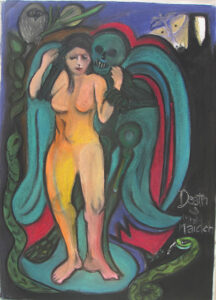
Death and the Maiden
As industrial modernity ushered an increasingly complex society and culture, the hegemony of the European art academies as the sole arbiter of taste collapsed under the pressure of the pluralism of an endless variety of creative experiments. Aesthetic and pedagogical mandates were gradually relaxed and the notion of skill was redefined to accommodate that pluralism, leading to more flexible and diverse models of training. And needless to say, the canon not only became infinitely more complex than that of the previous era, but it was full of contradictions and paradoxes; projects were as diverse as Mondrian’s and Picasso’s, or that of the German Expressionists and the Italian Futurists. In such a scenario, while zealously nurturing the notion of a distinct otherness, the countless modernist experiments with the vocabulary of a distant, “outside” art paradoxically made the divide between the “inside” and the “outside” very much blurry. The French artist Jean Dubuffet, known for his passion for “outsider” art, is a case in point. He even coined the term Art Brut (brute art) to describe what he believed to be the raw, intellectually unfettered character of his own images that resulted from his engagement with the creative pursuits of the insane and children. In other words, his attraction for the exotic (including the insane and children, a condescending position that indicates another problematic aspect of Primitivism) urged him to see himself as an “outsider” artist. Are we, however, ready to take such self-proclamation at face value? Do we not see it as a deliberate effort of an intellectually inquisitive mind to transgress precisely the boundaries of that intellectual enterprise which defines his identity as an artist?
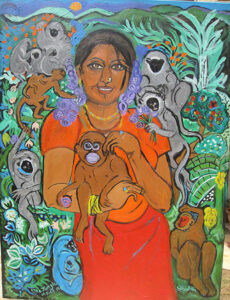
The Monkeys on My Back
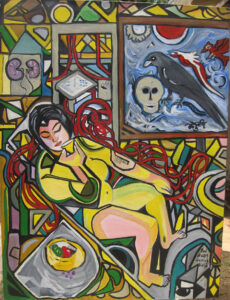
Dreams During Dialysis
The point I am trying to make is this: across such an uncertain and unstable “inside/outside” distinction, which cannot be defined adequately by either the question of art school attendance or by any specific pictorial logic, references and influences can and do travel in all directions; for unlike in the nineteenth century, today it is not difficult for one to absorb the pictorial language taught at art schools without attending one. A scrutiny of Singh’s pictures, for example, exposes citations from multiple sources. Pictorial motifs from as diverse art forms as the Indian miniature and Bengal pat painting are juxtaposed with glimpses of modernist imagery; shadows of Symbolists like Edvard Munch and Paul Gauguin (Anxiety, Death and the Maiden, The Monkeys on My Back), and Expressionists like Ernst Ludwig Kirchner and James Ensor (Dreams During Dialysis, Football Fever, Ship of Fools) inform both the figurative and the decorative in the images. Let us note that all of these artists were well-known Primitivists. Furthermore, Singh’s Born Defective is not only somewhat reminiscent of Francis Bacon’s disfigured faces from the 1950s, but the alternative title “Elephant Man” scribbled above the head is evidence of her knowledge of the story of Joseph Merrick, a man with severe deformities in nineteenth-century England, and of the 1980 film with the same title. No surprise there, since Singh’s social origin, education and exposure account for her acquaintance with all such sources, whether or not she actually went to art school. So what do we have here? If these artists passionately reached out for an “outside” –be it a space on the fringes of their own society, an era in its past, or some distant culture—to reinvent the canon, then Singh’s work cites their motifs and synthesizes them with other influences from non-Western cultures to produce a look of “outside” art. It is perfectly possible, even probable that the traces of the artists I locate here result from Singh’s general fascination for “outsider” art, rather than from fully conscious choices, but the outcome is all the same: the unconventional appearance of her images is, in fact, thoroughly mediated by conventions –cultivated constructs, not natural phenomena– well recognized in the history of modern art. Thus, I find Singh’s art different from that of many others, but certainly not anywhere on the “outside” of the dominant discourse of contemporary art.
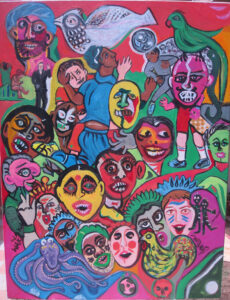
Football Fever
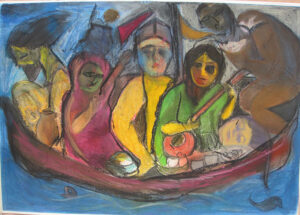
Ship of Fools
No matter how much I problematize the “insider/outsider” binary in modern art, not only has it managed to survive, but it still has considerable influence over some collectors, artists, critics and art historians, and most importantly, over the art market. Thus, it is definitely possible that Subhadarshini Singh’s work will be framed by such agents as “outsider” art, anyway. For me, on the other hand, to see it as such is to miss out on its critical potential. Singh sees herself as a contemporary story-teller, deeply committed to her mission of revealing the intricacies of medicine; and quite unlike most other serious artists, she is steadfastly attentive to this one subject. For me, however, she is a contemporary Indian artist who doesn’t simply offer stories about maladies and their healing, but does so through visual images. As a matter of fact, I see her images outliving the subject. My position here is likely to be quite opposite to the artist’s own; but if the subject is to have primacy, then I believe the conventional mediums of the visual arts today certainly aren’t the most effective vehicles for that project. If, on the other hand, we see her as a visual artist first, then her work becomes worthy of critical scrutiny, and we find her moving freely across imagined rubrics and ambiguous binaries in the discourse of contemporary art, defying easy categorization. If stories are linguistic representations of past events, real or imagined, then pictures of stories are representations of representations, at least twice removed from life; and in this regard, her Save that Stuff appears especially symbolic to me. It shows a curious museum, a diverse collection of medical images and paraphernalia that perhaps signifies Singh’s own desire to own such a collection. Yet if a museum is a representation of life due to its act of recontextualizing and classifying fragmented artifacts, then what we have here is not an actual museum, but a picture of one. Artifacts in this meta-museum are classified to construct a narrative about the human body, its suffering, decay, and the craft of healing.

Save that Stuff

